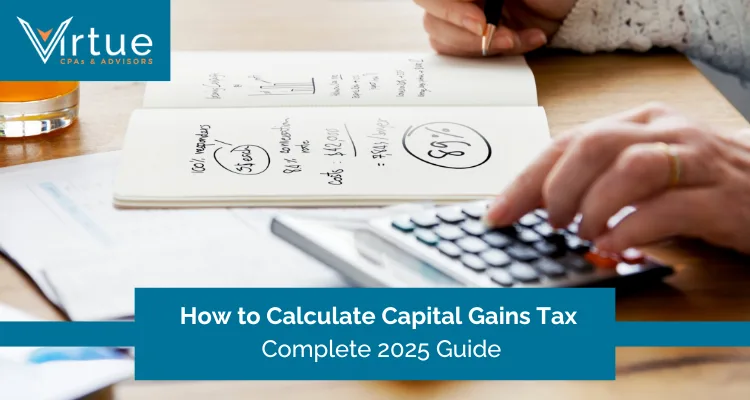You’ve worked hard to grow your investments—stocks, real estate, maybe even crypto.
But when you sell those assets, you can’t forget the tax man.
That’s where capital gains tax (CGT) comes in.
In 2025, some nuances in the tax rules have shifted, So you’ll want to know exactly how to calculate your tax liability, what rules apply, and how to make smart choices.
In this guide, you’ll learn from start to finish:
- What is capital gains tax?
- The rates you’ll face in 2025
- A step-by-step method to calculate how much you owe
- Deductions, exemptions, and special cases
- Strategies to reduce your tax
- And answers to common questions
Let’s jump in!
What is Capital Gains Tax?
When you sell an asset for more than what you paid, that profit is a capital gain.
The U.S. government typically taxes that gain. That’s the capital gains tax.
Here are a few key points so you don’t get confused:
- You only pay capital gains tax when the gain is realized—i.e., when you sell the asset, not while you just hold it.
- There are short-term gains (if you held the asset ≤ one year) and long-term gains (if you held it > one year). They’re taxed differently.
- Assets subject to CGT include stocks, real estate, crypto, collectibles, and more.
- Some gains may be excluded or reduced via special rules or exemptions.
Example: Suppose you bought shares for $5,000 and later sold them for $8,000. That $3,000 difference is your capital gain. The tax you pay depends on how long you held those shares and which tax bracket you fall into.
So before worrying about rates, you need to know your cost basis, your sale price, and how long you held the asset.
At Virtue CPAs, we often see clients confused about when CGT applies. Our advisors help you determine if your gains are taxable and identify exemptions you might qualify for—so you only pay what’s required, not a dollar more.
Capital Gains Tax Rates in 2025
Tax brackets can change each year, and 2025 is no exception.
Our experts at Virtue CPAs monitor IRS updates closely to ensure our clients stay compliant and optimized for savings.
Long-Term Capital Gains Rates
If you hold an asset for more than one year, you qualify for long-term capital gains rates.
In 2025, these remain at 0%, 15%, or 20%, depending on your taxable income.
| Filing Status / Income Level | Rate |
|---|---|
| Up to ~$48,350 (single) | 0% |
| ~$48,351 to ~$533,400 | 15% |
| Over ~$533,400 | 20% |
If you’re married filing jointly, those threshold numbers shift upward.
Also, keep in mind that the Net Investment Income Tax (NIIT) of 3.8% may apply if your income is above certain levels.
Short-Term Capital Gains Rates
If you held the asset for one year or less, that gain is “short-term” and is taxed at your ordinary income tax rate (i.e., the same rates as wages).
The ordinary rates in 2025 continue to be 10%, 12%, 22%, 24%, 32%, 35%, and 37% depending on your total taxable income.
Step-by-Step: How to Calculate Capital Gains Tax
Now let’s walk through how you calculate your capital gains tax, step by step.
Step 1: Determine Cost Basis
Cost basis is essentially what you paid to acquire the asset, including purchase price, broker fees, commissions, and improvements (for of real estate).
For example:
- You bought stock for $10,000 and paid $50 commission—your basis is $10,050.
- You bought a house for $200,000, then spent $20,000 on an approved home improvement—that $20,000 adds to your basis.
Step 2: Determine Selling Price & Net Proceeds
The selling price is what you received when you sold the asset, minus selling costs (commissions, fees, closing costs).
So if you sold stock for $15,000 and paid $100 in fees, your net proceeds are $14,900.
Step 3: Subtract Cost Basis from Proceeds → Gain (or Loss)
Capital Gain = Net Proceeds – Adjusted Cost Basis
If that number is negative, you have a capital loss. (Losses may offset gains, but that’s a separate topic.)
Step 4: Determine Holding Period (Short-term vs. Long-term)
If you held the asset for more than one year, you use long-term rates.
If one year or less, use short-term (ordinary income) rates.
Step 5: Apply the Correct Tax Rate & Compute Tax
For long-term gains, use the 0%, 15%, or 20% bracket that matches your income.
For short-term gains, use your marginal income tax rate.
Let’s do a worked example:
Example – Stock Sale
- You bought shares 18 months ago for $5,000 (basis).
- You sold them now for $12,000 and paid $100 in fees.
- Net proceeds: $11,900
- Gain = $11,900 – $5,000 = $6,900
- Because you held more than one year, it’s long-term.
- Let’s say your taxable income falls in the 15% long-term bracket.
- Your capital gains tax = 0.15 × $6,900 = $1,035
Deductions, Exemptions & Allowances
You’re in luck: not all gains are taxable.
There are deductions, exemptions, and allowances you can use to reduce what you owe.
Primary Residence Exclusion (Section 121)
If you sell your main home, you may be able to exclude up to $250,000 of gain (or $500,000 if you’re married filing jointly).
To qualify, you must have:
- Owned the home for at least 2 of the last 5 years
- Lived in it as your primary residence for at least 2 of the last 5 years
- Not used this exclusion for another home sale in the past 2 years
If your gain is below those exclusion limits (e.g. $200,000 gain for a single filer), you pay no capital gains tax.
Retirement Accounts & Tax-Advantaged Accounts
If your investments are held inside accounts like 401(k)s, IRAs, or Roth IRAs, you generally don’t pay capital gains tax while the asset remains in those accounts.
However, when you withdraw, you may pay ordinary income tax (depending on the account type).
Small Business & Special Exemptions
In some cases, gains from qualified small business stock (held long enough under Section 1202) may enjoy special exclusions.
This is more advanced; you’ll want professional help in that situation.
Also, some capital gains from certain investments in “Opportunity Funds” held for 10+ years may be excluded.
Special Cases of Capital Gains Tax
Certain types of assets or situations have unique rules.
Let’s look at the most common ones you might face.
Real Estate (Homes, Rental Properties)
- The primary residence exclusion applies (as above) up to $250,000 / $500,000.
- If you have a rental or investment property, you might not get the full exclusion.
- You need to account for improvements, depreciation (if applicable), and depreciation recapture.
- The gain might also trigger state tax depending on where you live.
Investments: Stocks, Bonds, Crypto
- These follow the standard short-term vs. long-term rules.
- Crypto is treated like property under U.S. tax rules, so gains are capital gains.
- Brokerage statements (Form 1099-B) usually report proceeds and basis, making your life easier.
Inheritance & Gifts
- If you inherit an asset, you often benefit from a step-up in basis. That means your basis is the fair market value on the date of the decedent’s death, reducing your gain.
- If you gift an asset, the recipient generally takes your basis (carryover basis).
- Special rules and gift tax issues may apply.
Business Sales & Asset Dispositions
- Selling your company or business assets can trigger capital gains tax, but some portions may be ordinary income depending on depreciation recapture.
- The nature of the asset (goodwill, equipment, real estate) matters.
Foreign Investments & Double Taxation
- If you invest abroad, you might owe taxes in both countries.
- Many U.S. taxpayers can claim a foreign tax credit to avoid double taxation.
- Treaties between the U.S. and other nations may reduce or eliminate taxes on foreign capital gains.
Many people miss opportunities to save because they don’t know the full list of deductions.
That’s where Virtue CPAs steps in.
We help clients:
- Maximize home sale exclusions
- Leverage retirement account tax advantages
- Qualify for small business and investment exemptions
By reviewing your entire financial picture, our experts ensure you benefit from every deduction the law allows.
Strategies to Minimize Capital Gains Tax
You don’t always have to pay the maximum possible.
At Virtue CPAs, we use proven strategies such as:
- Tax-Loss Harvesting - If you have investments that have lost money, you can sell them to realize a capital loss, which offsets gains. If losses exceed gains, up to $3,000 of losses can offset ordinary income (the rest can carry forward).
- Holding Period Strategy - By holding an asset for more than one year, you may shift from short-term (higher) rates to long-term (lower) rates. Don’t sell too early unless needed.
- Use Retirement Accounts - Holding assets inside IRAs, 401(k)s, or other tax-advantaged accounts shields you from capital gains tax while inside the account.
- Gifting & Estate Planning - Gifting assets to family (especially in lower tax brackets) may reduce taxes. Also, using trusts or estate planning strategies can help shift your gains to others in favorable tax positions (with care).
- Relocation to Tax-Friendly States - Some states do not tax capital gains (or have very low rates). If you move to such a state, your state-level CGT may drop.
Conclusion
You’ve now got a full roadmap for understanding, calculating, and minimizing capital gains tax in 2025.
You learned what CGT is, how to handle short-term vs. long-term gains, how to compute your liability, and some smart strategies to reduce what you owe.
But here’s the thing: tax rules are complex. Small mistakes can cost you thousands. You deserve to get this right.
That’s why Virtue CPAs is here to help. Our team of licensed professionals specializes in tax planning and capital gains strategies. Whether you're selling property, managing investments, or planning your estate, we can step in to make sure you save legally and efficiently.
Contact Virtue CPAs today for a consultation. Let’s work together to keep more of your hard-earned money in your pocket.
Frequently Asked Questions







